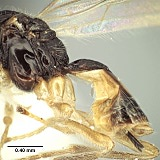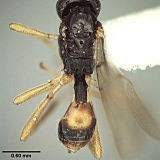Stigmatopoea Fischer, 1986
Remarks
Eurytenes was originally described by Foerster (1862) to accommodate Opius abnormis Wesmael, 1835, a species with distinctive wing venation. Despite numerous changes in opiine classification since Foerster (1862), Eurytenes has almost universally been treated as a valid genus (see Quicke et al. 1997 for an exception). Wharton (1988) broadened the concept of Eurytenes by including Opius macrocerus Thomson, 1895, and Fischer (1998) expanded the concept further, proposing six subgenera (Eurytenes s. s., Jucundopius Fischer, 1984; Stigmatopoea Fischer, 1986; Xynobiotenes Fischer, 1998; Oetzalotenes Fischer, 1998; Opiotenes Fischer, 1998). Fischer (1998) included 16 species, and 11 others have been added through 2012 (Chen and Weng 2005, Wu and Chen 2006, Walker and Wharton 2011, Wharton et al. 2012). Van Achterberg (2004) recognized Xynobius Foerster, 1862 as a valid genus and transferred Stigmatopoea to it but did not discuss Eurytenes. Wharton (2006) placed Xynobius as a subgenus of Eurytenes. Eurytenes s. s. is defined by the attachment of the radial cross-vein® to the extreme base of the stigma. In the remaining subgenera of Eurytenes s. l. (Xynobius, Jucundopius, Stigmatopoea, Xynobiotenes, Oetzalotenes, and Opiotenes), r arises more distally along the stigma.
Wharton (1988, 2006), Fischer (1998), and Wu and Chen (2006) provide diagnoses for Eurytenes s. s. and s. l.
Taxonomic History / Nomenclature
Opius (Stigmatopoea Fischer, 1986: 609-611). Type species: Opius macrocerus Thomson, 1895. Original designation.
Eurytenes (Stigmatopoea): Wharton 1988: 357 (revised status); Fischer 1998: 21, 22, 25 (keys, diagnoses of subgenera); Walker and Wharton 2011: 24 (review of classification).
Xynobius (Stigmatopoea): van Achterberg 2004: 314-315 (revised status, keys to subgenera).
Eurytenes (Xynobius): Wharton 2006: 330-333 (revised status, relationships).
Eurytenes (Stigmatopoea): Wharton 1988: 357 (revised status); Fischer 1998: 21, 22, 25 (keys, diagnoses of subgenera); Walker and Wharton 2011: 24 (review of classification).
Xynobius (Stigmatopoea): van Achterberg 2004: 314-315 (revised status, keys to subgenera).
Eurytenes (Xynobius): Wharton 2006: 330-333 (revised status, relationships).
We follow Wharton (1988, 2006) and Fischer (1998) in treating Stigmatopoea as a subgenus of Eurytenes. Wharton (2006) provides a detailed morphological discussion of this and alternative classifications.
Type locality of macrocerus: France; primary type in Lund.
Description
Diagnosis and Relationships
Mandible without basal tooth or lobe ventrally. Labrum broadly exposed. Occipital carina broadly absent dorsally, present laterally. Propleuron ventral-laterally without oblique carina. Notauli deep, well developed anteriorly, varying posteriorly from largely absent to deep and extending to scuto-scutellar sulcus or nearly so; midpit present. Fore wing stigma long, narrow, parallel-sided, discrete posteriorly, r1 arising distinctly basad its midpoint; second submarginal cell with 2RS shorter than 3RSb; 2CUb arising above middle of hind margin of first subdiscal cell. Dorsope present; S1 0.2-0.3 x length of T1, never fused to T1.
Distribution
No referenced distribution records have been added to the database for this OTU.
Biology / Hosts
Known hosts are primarily parasitoids of leaf-mining and fruit-infesting Tephritidae.



